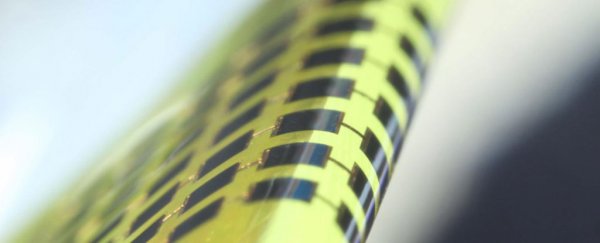Solar power is totally peaking right now, smashing through cost barriers that previously held the technology back, to the extent that in some parts of the world, surplus energy from sunlight is being given away for free.
But if we're ever going to unlock the true potential of solar, we need to think beyond today's large rooftop solar panels, and examine what smaller, lightweight, and even wearable solar cells could do for us.
That's the thinking behind new flexible, ultra-thin photovoltaic cells developed by researchers in South Korea. These things are so bendable, they can be wrapped around a pencil – or something even smaller. In the image above, the cell material is folded around the edge of a 1-mm-thick glass slide.
"Our photovoltaic is about 1 micrometre thick," said engineer Jongho Lee from the Gwangju Institute of Science and Technology.
That makes it much, much thinner than a human hair – which range from to 10 to 200 micrometres in width – whereas standard photovoltaic cells can be hundreds of times thicker.
That extreme thinness means one day we might be able to sport amazingly lightweight solar cells on personal electronics devices such as fitness trackers and smart glasses powered exclusively by the light around them.
It also gives the panels huge flexibility and bend resistance, which could come in real handy for applications that need to be highly adaptive or wearable, such as fabrics and clothes.
The team developed the material using the semiconductor material, gallium arsenide, stamping the cells directly onto a flexible substrate, and cold welding the cells to the electrode on the substrate. A metal layer underneath the photovoltaics acts as a reflector to bounce any stray photons onto the cells.
In the researchers' testing, reported in Applied Physics Letters, bending tests showed that the ultra-thin cells could wrap around a radius as tiny as 1.4 millimetres, while only experiencing about a quarter the amount of strain of other kinds of thin solar cells (measuring 3.5 micrometres in thickness).
"The thinner cells are less fragile under bending, but perform similarly or even slightly better," said Lee.
We saw a similar approach to extremely thin solar cells earlier this year, when researchers at MIT developed photovoltaics so light, they could even rest on a soap bubble without bursting it. The only problem with those solar cells is that they were so light, they were borderline unusable.
"If you breathe too hard, you might blow it away," said one of the MIT team, Joel Jean, at the time.
But scientists aren't only interested in making solar panels smaller and lighter – they're also working hard to make solar panels more effective.
Last year, scientists from Stanford University developed solar cells that can absorb significantly more sunlight than traditional panels, by using 'nano-wires' that effectively make the upper metal contact on the cell invisible, letting the unobstructed cell absorb more energy from the Sun.
And just last month, researchers from the University of New South Wales (UNSW) in Australia set a new world record for solar efficiency, building photovoltaic cells that can harvest more than a third (34.5 percent) of the Sun's energy without concentrators.
This technique, which sailed past the previous record of 24 percent, absorbs more energy by splitting incoming sunlight into four separate bands.
"This encouraging result shows that there are still advances to come in photovoltaics research to make solar cells even more efficient," said researcher Mark Keevers, when the record was announced. "Extracting more energy from every beam of sunlight is critical to reducing the cost of electricity generated by solar cells as it lowers the investment needed, and delivering payback faster."
It's truly awesome to see all these advancements taking place in solar power, and with scientists calculating that rooftop solar alone could satisfy almost half of US power demands, it's clear we're only at the beginning of an epic transition away from reliance on fossil fuels.
Watch this space.
